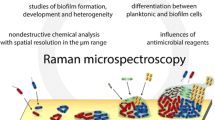Abstract
The biofilm-forming fungus, Aureobasidium pullulans DSM 2404, was grown in a bead-packed reactor. Alterations within the reactor were analysed in several cross-sectional slices by magnetic resonance imaging (MRI) with flow contrast. For the first time, biofilm accumulation could be continuously elucidated without using any contrast agents, and the non-stationary flow through the fixed-bed reactor could be visualized. The results indicate that the non-stationary flow through the biofilm reactor changes significantly due to the changing reactor morphology. Preferential flow lines arise during biofilm formation. The accumulation of the biomass was determined and compared to gravimetrical biomass data. The described technique can be used to monitor hydrodynamic transport, and to combine flow-field characteristics with morphological data for the prediction of undesirable reactor processes, e.g. clogging.
Similar content being viewed by others
References
Cunningham AB, Characklis WG, Abedeen F, Crawford D (1991) Influence of biofilm accumulation on porous media hydrodynamics. Environ Sci Technol 25:1305–1311
Heinen C, Buggisch H, Guthausen G (2003) Flow of newtonian/non-newtonian fluids in a bundle of tubes and in a packing of beads by MRI. Magn Reson Imaging 21:377–379
Hoskins BC, Fevang L, Majors PD, Sharma MM, Georgiou G (1999) Selective imaging of biofilms in porous media by NMR relaxation. J Magn Reson 139:67–73
Manz B, Volke F, Goll D, Horn H (2003) Measuring local flow velocities and biofilm structure in biofilm systems with Magnetic Resonance Imaging. Biotechnol Bioeng 84:424–432
Manz B, Volke F, Goll D, Horn H (2005) Investigation of biofilm structure, flow patterns and detachment with magnetic resonance imaging. Water Sci Technol 52:1–6
Nott KP, Heese FP, Hall LD, Macaskie LE, Paterson-Beedle M (2005) Measurement of flow field in biofilm reactors by 3-D Magnetic Resonance Imaging. AIChE J 51:3072–3079
Nott KP, Paterson-Beedle M, Macaskie LE, Hall LD (2001) Visualisation of metal deposition in biofilm reactors by three-dimensional Magnetic Resonance Imaging (MRI). Biotechnol Lett 23:1749–1757
Oliveira SVWB, Moraes EM, Adorno MAT, Varesche MBA, Foresti E, Zaiat M (2004) Formaldehyde degradation in an anaerobic packed-bed bioreactor. Water Res 38:1685–1694
Paterson-Beedle M, Nott KP, Macaskie LE, Hall LD (2001) Study of biofilm within a packed-bed reactor by three-dimensional magnetic resonance imaging. Method Enzymol 337:285–305
Seymour JD, Codd SL, Gjersing EL, Stewart PS (2004) Magnetic resonance microscopy of biofilm structure and impact on transport in a capillary bioreactor. J␣Magn Reson 167:322–327
Sharp RR, Stoodley P, Adgie M, Gerlach R, Cunningham A (2005) Visualization and characterization of dynamic patterns of flow, growth and activity of biofilms growing in porous media. Water Sci Technol 52:85–90
Soares A, Guieysse B, Mattiasson B (2003) Biodegradation of nonylphenol in a continuous packed-bed bioreactor. Biotechnol Lett 25:927–933
Stapf S, Han S-I (eds) (2006) NMR imaging in chemical engineering. Wiley-VCH, Weinheim
Zwiener C, Frimmel FH (2003) Short-term tests with a pilot sewage plant and biofilm reactors for the biological degradation of the pharmaceutical compounds clofibric acid, ibuprofen, and diclofenac. Sci Total Environ 309:201–211
Acknowledgements
This work was supported by grants of the Deutsche Forschungsgemeinschaft (DFG): the DFG Research Unit FOR 338 “Application of Magnetic Resonance to the investigation of structure and transport processes in disperse systems”, and the DFG Research Training Group 366 “Interfacial phenomena in aquatic systems and aqueous phases”. Manfred Haug and his team are gratefully acknowledged for their skilful technical help in reactor design. We also would like to thank Emilio Oliver-Gonzales for assistance with the MRI measurements.
Author information
Authors and Affiliations
Corresponding author
Rights and permissions
About this article
Cite this article
Metzger, U., Lankes, U., Hardy, E.H. et al. Monitoring the formation of an Aureobasidium pullulans biofilm in a bead-packed reactor via flow-weighted magnetic resonance imaging. Biotechnol Lett 28, 1305–1311 (2006). https://doi.org/10.1007/s10529-006-9091-x
Received:
Accepted:
Published:
Issue Date:
DOI: https://doi.org/10.1007/s10529-006-9091-x




